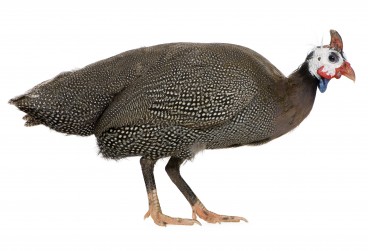Guinea Fowl from The Wise Encyclopedia
GUINEA FOWL. Usually referred to as guinea hen, Numida meleagris, of North and West Africa, is related to the pheasants, and has been domesticated in most parts of the world. This bird was known to the ancients. The Greeks, Phoenicians and the Romans had it at their banquets, holding it in special favor.There are two species of guinea fowl--both coming from Africa--one having wattles of turquoise blue, and the other with wattles of tender pink. The plumage of both is slaty gray variegated with white spots. One writer relates: "Whence the ancient Latin and modern specific name meleagris, the spots being fancifully taken for the tears shed by the sisters of Meleager at his fate." The guinea is agile, and with its symmetrical form and sparkling feathers it is an ornamental bird. Its screech, however, adds nothing of beauty to the domestic scene, but its cry is often lost in the chorus of the clucking turkey and the brass bands of roosters.
On our tables the guinea hen occupies a special place. The roast is indeed he favorite way to cook it, and it must be served with turnips. Select a young and tender bird, finely lard it or cover it with a thin sheet of pork fat and roast in a hot oven. Baste it with strictly fresh butter. Stuff with truffies for that extra savory flavor. For sheer goodness this tantalizing dish is the ultimate in pleasures of the eye and tongue. In Italy, especially in Messina, no Sunday dinner is complete without roast guinea hen accompanied by fresh soft figs and perfumed oranges.
The eggs of the guinea hen are greatly esteemed in Europe but they are not in special favor in the United States.
From The Wise Encyclopedia of Cookery, 1971.
